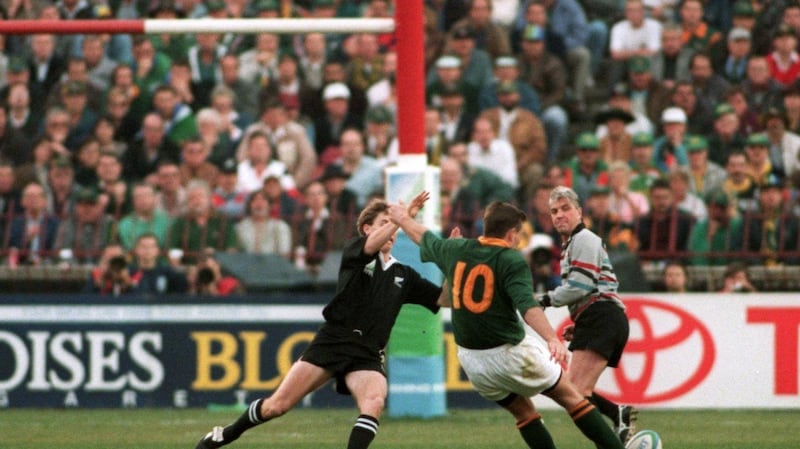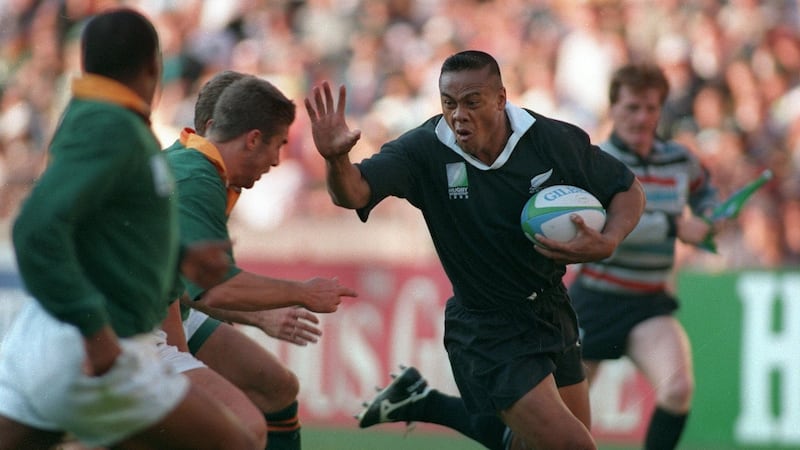Poisonous coffee. The Friday morning before the World Cup final Frank Bunce gingerly moved off his toilet bowl to track down Dr Mike Bowen.
“Doc, I got the shits.’”
Dr Bowen showed Bunce “a room full of people who were worse off”. Twenty-six of the 37-strong All Blacks touring party were projectile vomiting and suffering from free-flowing diarrhoea.
"It looked like something out of Saving Private Ryan," recalled Rory Steyn, Nelson Mandela's bodyguard before he was assigned to New Zealand's security detail for the tournament. "There were guys lying on the floor outside the doctor's room down the passage, and the doctor and the physio were administering electrolytes and injections.
"Jeff Wilson was the worst of the lot. He didn't make half-time."
Andrew Mehrtens, despite playing 100 minutes and missing a late drop goal to capture William Webb Ellis, was a close second.
The source of infection remains unknown. Dr Bowen attempted to get food samples and the player stools to a nearby hospital for testing.
"I didn't get any assistance there at all," he told journalist Wynne Gray in 2015.
“There wasn’t a common denominator on the food but there was with the water or the drinks. That was the only potential.
"I did speak to a number of South Africans, subsequently, and they said there is a particular vegetable poison which occurs naturally in South Africa which you could put into a drink. It is colourless, odourless and easy to use. But hey, that's only hypothesis."
Dr Bowen drank the tea. Otherwise, history would have been forced onto an entirely different course.
New Zealanders are the ultimate sportspeople when it comes to taking it on the chin. Losing tears at their soul, and revenge is always swift, but the Kiwis can swallow defeat like no other breed. That's what makes the behaviour of head coach Laurie Mains in the wake of the 1995 World Cup final so remarkable to this day.
Mains refused to accept Joel Stransky’s winning drop goal as a sporting upset for the ages. The sight of his violently ill players in the 48 hours leading up to the game compelled him to uncover the truth. He too was struck down by the bug.
His wife, Annemarie, nudged him towards a private investigator to track down Suzie, a mysterious waitress, supposedly hired by the Johannesburg hotel two days before the All Blacks checked in.
Into the murky South African waters, where sport is weaved into politics, we must go.

The All Blacks looked invincible in 1995 (they proved as much on return to South Africa in 1996). After humiliating England in the semi-final it was universally agreed that the sport was bearing witness to its greatest ever team. It wasn't just the transcendent impact of Jonah Lomu, it was the leadership of Sean Fitzpatrick, the magnificence of Zinzan Brooke, Ian Jones, Wilson, Bunce and Walter Little that made them such an irresistible force.
Unbeatable, it seemed.
Let's skip to the post-match dinner, shortly after Nelson Mandela and Francois Pienaar's iconic moment and just as Dr Louis Luyt grabs the microphone.
The president of South African rugby – described by Mandela as a “pitiless dictator” who eventually resigned following accusations of racism, nepotism and financial mismanagement – delivered an eight-minute speech that cleared the room.
Dr Luyt started by noting the illegitimacy of New Zealand’s World Cup win in 1987 and Australia’s in 1991 because “we weren’t there” due to apartheid. Then he claimed residency on Mars because the All Blacks are supposedly the greatest team on Earth so the Springboks must be from another planet.
Severely dehydrated All Blacks stood up and walked out, but not before future Leinster forwards coach Mike Brewer and Luyt had a verbal exchange.
None of this comes close to what happened to them on that Thursday before the definitive moment of their careers.
“Do I think it was intentional? Absolutely,” Steyn stated in 2018, doubling down on his memoir One Step Behind Mandela. “Do I think South African rugby was involved? Absolutely not.”
“I say to every South African: ‘It happened.’ Sadly it happened on my watch. That is something that I still take incredibly personally.”
Steyn agrees with the report from Mains' private investigator that a betting syndicate poisoned the New Zealand camp.
Mains: “The private investigator did establish that a black lady had been employed by the hotel two days before we arrived and that day after we got sick, she disappeared completely.
“About two months later a very prominent financier from New Zealand advised me that the word of the street in financial circles in London was that bookmakers were behind it.”
That was enough for Mains to settle upon the organised crime theory, which places this tale in the same category as Arnold Rothstein bribing the 'Black Socks' to throw the World Series in 1919 ("Say it ain't so, Joe").

The difference is the Chicago players were directly involved in baseball's most scandalous fix. The similarity is everyone seems to know what happened.
Everyone except then SA Rugby CEO Ed Griffiths (yes, the very same interim CEO of Saracens for 26 days).
“Look, it’s true that five or six of them did have a stomach upset,” Griffith told Rugby Pass in May. “But all I would say on that is they ate seafood, sort of prawns, crayfish and stuff days before a World Cup final. I mean, most people would know that seafood is something that at the wrong time can give you food poisoning and clearly some of them seemed to have picked up food poisoning from that.”
Tony Rubin, a manager at the hotel, stated in 2003 that "I never met Suzie, there was no Suzie. She didn't exist," before adding: "It was something Laurie Mains dreamt up."
The seafood restaurant theory has been debunked by Dr Bowen who noted 26 of the touring party began to get “violently sick” from Thursday at 3pm. The players and management only went to the restaurant after the outbreak had begun.
"If the game had been played a day earlier we wouldn't have had a team," said All Black winger Eric Rush. "That's why it was suspicious. There was about four or five guys who shouldn't have played but it was the biggest game of their lives."
The management decided – following a meeting in Colin Meads’ bedroom as the legendary ‘Pinetree’ was too sick to budge – to keep the poisoning under wraps until after the final.
“I was the one who said we don’t have to tell anyone,” said Mains. “I didn’t want South Africa to know we were crook. It was the worst thing I did.”
Mains, who is 74 now, would be forgiven for continuing his search for Suzie, like one of those retired homicide detectives chipping away at a cold case, constantly revisiting the plush J’burg suburb in search of answers.
“If you let injustice sit inside you it will eat you,” he said years later. “But I’m not one of those people.”
Clint Eastwood completely ignored the poisoning in his 2009 movie Invictus. Same goes for John Carlin's book that the film is based upon, entitled: Nelson Mandela and the game that made a nation.
Even Griffith disagreed with this strapline: "The reality is that within three years South African rugby was putting Nelson Mandela in the dock because the government wanted to appoint a commission of enquiry into rugby and SA Rugby fought that commission in the court and Nelson Mandela was literally standing in the dock taking questions as a witness. The legacy was largely wasted...There was still too many people there who felt that rugby was a white man's game and should be kept as such."

iya Kolisi changed that perception forever in 2019 but a tragic epilogue to this game is the premature passing of four Springboks – Ruben Kruger (brain cancer), Joost van der Westhuizen (motor neuron disease), James Small (heart attack), Chester Williams (heart attack) –and Lomu, all before they could settle into middle age.
"It is highly unusual," said Dion O'Cuinneagain, the Cape Town doctor and former Ireland captain. "So many people have passed away but I wouldn't want to get into that debate. Was it conditioning problems? Was it what they were eating? I don't know. I definitely don't want to get into that."
Nobody in South Africa seems interested in linking the bizarre chain of events before and after the 1995 World Cup final. Or ever finding Suzie.






















